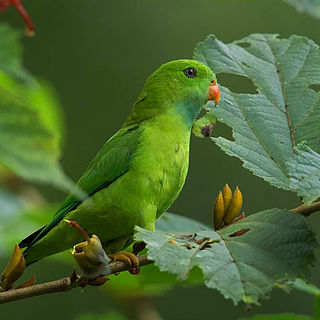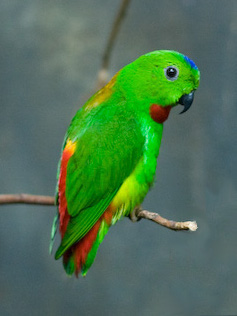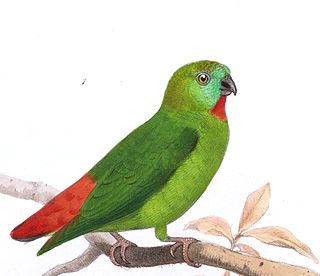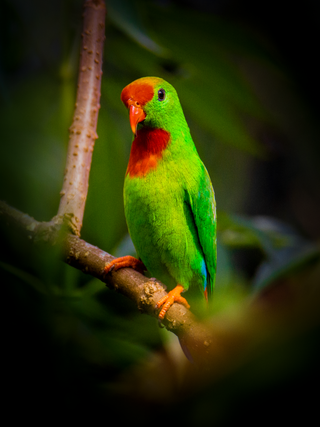
The Sri Lanka hanging parrot is a small parrot which is a resident endemic breeder in Sri Lanka.

The vernal hanging parrot is a small parrot which is a resident breeder in the Indian subcontinent and some other areas of Southeast Asia. It undergoes local movements, driven mainly by the availability of the fruit, seeds, buds and blossoms that make up its diet. They frequent the banyan tree for the fruit and plantain trees for the nectar from the flowers.

Hanging parrots are birds in the genus Loriculus, a group of small parrots from tropical southern Asia.

The blue-crowned hanging parrot is a parrot species endemic to southern Burma and Thailand, Malaya, Singapore, and Indonesia. These parrots are 12cm in height and weight 28g and have a longevity of 14 years. They are recognized by their green plumage, black beak and characteristic blue feathers arranged like a crown on their head.
Wallace's hanging parrot also known as the Flores hanging parrot, is a small parrot endemic to the island of Flores.

The Moluccan eclectus is a parrot native to the Maluku Islands (Moluccas). It is unusual in the parrot family for its extreme sexual dimorphism of the colours of the plumage; the male having a mostly bright emerald green plumage and the female a mostly bright red and purple/blue plumage. Joseph Forshaw, in his book Parrots of the World, noted that the first European ornithologists to see eclectus parrots thought they were of two distinct species. Large populations of this parrot remain, and they are sometimes considered pests for eating fruit off trees. Some populations restricted to relatively small islands are comparably rare. Their bright feathers are also used by native tribespeople in New Guinea as decorations.

The Moluccan king parrot is a parrot endemic to Peleng Island, Maluku, and West Papua in Indonesia. It is sometimes referred to as the Ambon king parrot or Amboina king parrot, but this is potentially misleading, as it is found on numerous other islands than Ambon. The male and female are similar in appearance, with a predominantly red head and underparts, green wings, and blue back and tail. Six subspecies are recognised, but only a few of these are regular in aviculture. In the wild, it inhabits rainforests and feeds on fruits, berries, seeds and buds.

Sclater's monal also known as the crestless monal is a Himalayan pheasant. The name commemorates the British zoologist Philip Lutley Sclater.

The golden swallow is a swallow endemic to the Caribbean island of Hispaniola and was once native to Jamaica, but is now extirpated there. It is restricted to isolated montane forests that primarily consist of the Hispaniolan pine. This species is considered to be a vulnerable species by the International Union for Conservation of Nature (IUCN). The exact cause of its extirpation from Jamaica is unknown, but likely factors include predation by introduced mammals and habitat loss, although the habitat loss theory is not supported by much evidence. The last sighting of the nominate subspecies was in Hardwar Gap, with three birds being seen on 8 June 1989.

The Sula megapode or Sula scrubfowl is a species of bird in the family Megapodiidae. It is found only in the Banggai and Sula Islands between Sulawesi and the Maluku Islands in Indonesia, where its habitats are subtropical or tropical dry forest, subtropical or tropical moist lowland forest, subtropical or tropical mangrove forest, and subtropical or tropical moist shrubland. It is threatened by habitat destruction.

Alisterus is a genus of medium-sized Australasian parrots, comprising the Australian king parrot, the Papuan king parrot and the Moluccan king parrot. The three species are respectively found in eastern Australia, Papua, the Moluccas and other Indonesian islands. Predominantly of red and green plumage, the long-tailed parrots are related to the genera Aprosmictus and Polytelis.

The Moluccan hanging parrot is a species of parrot in the family Psittaculidae. It is endemic to forest and nearby habitats on Halmahera, Bacan and Morotai in Indonesia. It has sometimes included the Sula hanging parrot as a subspecies, but the two are increasingly treated as separate species based on their distinct differences in plumage and size.

The orange-fronted hanging parrot or Papuan hanging parrot is a small species of parrot in the family Psittaculidae. It is endemic to forest in New Guinea and adjacent smaller islands. It sometimes includes the Bismarck hanging parrot as a subspecies.

The Philippine hanging parrot, also commonly known as the colasisi from its local Tagalog name "kulasisi", is a small psittaculid parrot species endemic to the Philippines. It includes about eleven subspecies, at least one of which might represent a distinct species, although further research is needed. While it is listed as Least Concern in IUCN, some subspecies, such as L. p. chyrsonotus of Cebu and L. p. siquijorensis of Siquijor, may already be extinct. The species is threatened by habitat loss, but a bigger threat is trapping for the illegal wildlife trade; wild-caught birds are often sold as pets in streets and online selling groups.

The great hanging parrot, also called Celebes hanging parrot, Sulawesi hanging parrot and maroon-rumped hanging parrot, is a species of parrot in the family Psittaculidae. It is endemic to Sulawesi and nearby smaller islands in Indonesia, where it occurs in forest, secondary growth and tall mangrove.

The Bismarck hanging parrot or green-fronted hanging parrot is a small species of parrot in the family Psittaculidae. It is endemic to forest in the Bismarck Archipelago in Papua New Guinea. It is threatened by habitat loss. It is sometimes considered a subspecies of the orange-fronted hanging parrot.

Agapornithinae is a subfamily of psittacine birds, one of the five subfamilies that make up the family Psittaculidae. Its members are small, short-tailed parrots that inhabit Africa and Asia. They usually have predominantly green plumage and present different colorations on the head.

















